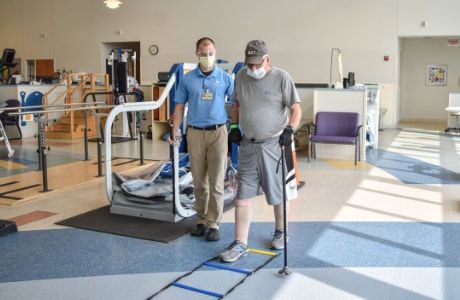Ready to be Steady: Fall Prevention Program at Fisher-Titus
By: Jeri Inmon, PT, Manager, Rehabilitation
September 20-26 is National Rehabilitation Awareness Week. This week we are proud to celebrate our dedicated rehabilitation professionals at Fisher-Titus and recognize the exceptional care they provide to patients in our community. Our Rehabilitation Team includes specialists with advanced training in Physical Therapy, Occupational Therapy, Speech Therapy, Audiology/Hearing, Pediatric Therapy, Cancer Rehabilitation, and Athletic Training. Therapy is customized for each individual patient and reflects the best evidence-based practices in the rehabilitation field.
One of the programs offered by Fisher-Titus Rehabilitation is the Ready to be Steady fall prevention program and post-fall management program.
Facts about Falls
Falls can be dangerous especially as individuals age. Here are some things to know about the dangers of falls:
- One out of every five falls causes a serious injury such as a broken bone or a head injury
- Over 800,000 patients are hospitalized every year because of a fall injury, most often because of head injury or hip fracture
- Over 300,000 older people are hospitalized every year for hip fractures
- More than 95% of hip fractures are caused by falling, usually by falling sideways
- Falls are the most common cause of traumatic brain injury (TBI)
Who is at risk of falling?
If you are concerned about your fall risk or the fall risk of a loved one, consider these questions:
- Do you feel less steady on your feet than you did one year ago?
- Have you had a fall recently?
- Do you ever lose you balance or feel dizzy?
- Do you have a fear of falling?
If you answered yes to any of these questions, you may be at increased risk of falling and could benefit from the Ready to be Steady program.
Ready to be Steady
Through the Ready to be Steady program, Fisher-Titus Physical and Occupational Therapists collaborate to create individualized programs for preventing falls with their patients.
The Ready to be Steady program focuses on preventing falls by targeting the five components of fall prevention:
- Strength - Strength is very important for the response of your body after a balance disturbance. Testing will identify weakness and, if necessary, exercises will be suggested to improve ankle and leg strength.
- Balance – Normal balance is controlled by a complex combination of visual, muscular, and neurological systems.. Together these systems keep individuals from falling when encountering a sudden loss of balance. Testing and exercise will improve your ability to remain upright during challenging conditions.
- Walking Speed & Step Length – Older adults typically have a slower walking speed. Steps may also be shorter and vary in length. Speed and step length help our bodies maintain balance. Testing and exercise may help you learn how to walk more safely and confidently.
- Environmental Modifications – In some cases, the setup of your home may limit your independence with certain activities such as showering and cooking. Education and instruction on possible changes to your home may improve your ability and safety when attempting these activities. These modifications and knowledge of proper use of equipment will decrease your risk of falls at home.
- General Health – Living a healthy lifestyle, keeping blood sugars and medications at a therapeutic level will help decrease your risk for falls.
During your first Ready to be Steady visit, patients receive an evaluation from a licensed therapist. The evaluation will include:
- Screening of general health, medical and surgical histories, and a review of current medications
- Assessment of your strength, flexibility, balance, and gait
- Completion of a functional outcome assessment
- Customized goals and program
After your evaluation and the development of your personalized fall prevention plan, you will continue to visit Fisher-Titus Rehabilitation for:
- Exercising to improve strength, balance, walking speed, step length, and flexibility
- Establishing exercises to complete at home with little or no equipment
- Practicing everyday activities to ensure you are completing them as safely as possible
- Establishing methods to maximize safety in the home environment
Your therapists may even recommend a home evaluation as part of your fall prevention plan to help determine what fall hazards there may be in your home and what modifications can be made to make your environment safer.
During your final Ready to be Steady session, you will review your home programs with your therapist(s), progress reports will be sent to your primary care provider, and your therapist will address any remaining questions you may have.
How to Enter the Ready to be Steady Program
To begin the Ready to be Steady fall prevention program, you will need a referral from a doctor. Talk to your doctor if you think you might benefit from the program. You can also get more information from the Fisher-Titus Rehabilitation Department by calling (419) 660-2700 or by visiting fishertitus.org/rehab.
About Jeri
Jeri Inmon, PT is Manager of Rehabilitation at Fisher-Titus. The Fisher-Titus Ready to be Steady program is based on well established and researched science. Fisher-Titus Rehabilitation professionals utilize technology and assess individualized needs to develop an objective and personalized program. They are dedicated to helping improve the safety and mobility of their patients as well as increasing their independence with day-to-day activities.
